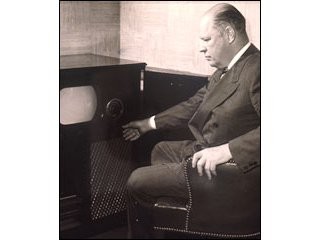
Allen B. DuMont biography
Date of birth : 1901-01-29
Date of death : 1965-11-14
Birthplace : Brooklyn, New York City, United States
Nationality : American
Category : Science and Technology
Last modified : 2011-09-29
Credited as : scientist, inventor radar, Cathode ray tube
1 votes so far
Early CRTs had a lifespan of barely 24 hours, but DuMont was able to engineer a cheaper yet much longer-lasting tube, which had its first successful application in oscillographs. His best early customer was Ernest Lawrence, who used DuMont's CRTs in his atomic research. DuMont also invented what was called a "magic eye", a CRT-based radio tuning indicator, and he described the principles of what would later be called radar, but he was asked by the Army Signal Corps not to patent his findings, for reasons of national security. In 1938 his company became the first to manufacture television receivers, using CRTs as picture tubes, as he had proposed to De Forest. In 1940 DuMont was licensed to operate its first experimental television station, W2XWV in New York City, and in 1944 W2XWV became a commercial station under its founder's initials, WABD (now WNYW).
DuMont joined the Westinghouse Lamp Company, Bloomfield, N.J., in 1924 as an engineer in the development laboratory. He developed high-speed manufacturing and testing equipment that allowed Westinghouse to increase its production to 50,000 vacuum tubes per day.
In 1928 DuMont became chief engineer of the De Forest Radio Company in Passaic, N.J., where he became interested in the patents and equipment of Charles F. Jenkins, who had established an experimental television station in the early 1920s. Working from Jenkins's patents, DuMont set up a simultaneous picture and sound broadcast in 1930 and concluded that electromechanical systems were inadequate for practical television and that a purely electronic system was needed.
DuMont set up a company in 1931 that later was known as Allen B. DuMont Laboratories, Inc. He improved cathode-ray tubes and developed the modern oscilloscope, widely used in the laboratory for the measurement and study of wave forms.
In 1937 DuMont began manufacturing the first commercial television receivers, which were based upon his improved cathode-ray tube. His company also established experimental television transmission facilities and marketed the first postwar television receivers.
DuMont served with the National Television System Committee, which formulated the broadcast standards for both black-and-white and colour television. He also worked with the Federal Communications Commission concerning the allocation of frequencies for television channels.
















